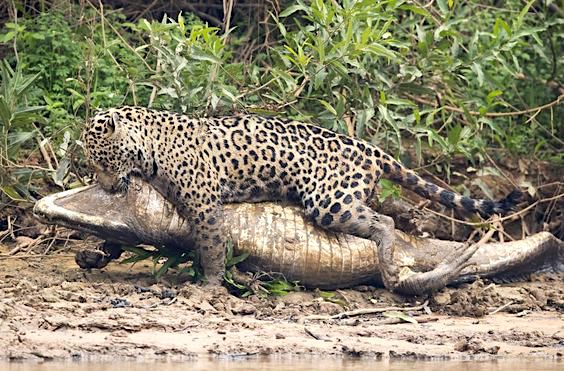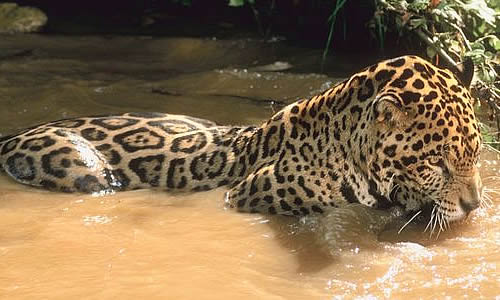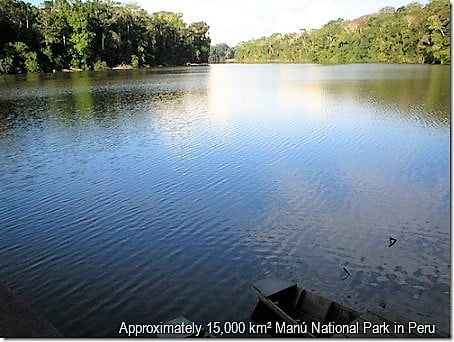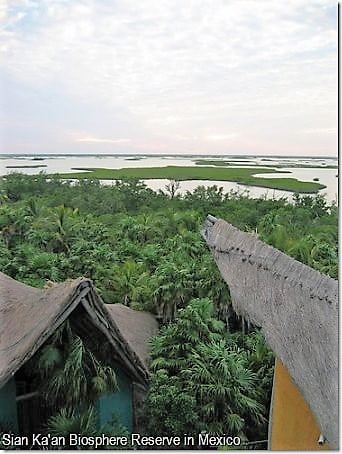Jaguars can be seen in a range of tropical and subtropical habitats. They can live at sea level to about 1,200 m above sea level. There are records of jaguars living at 3,800 m above sea level in Costa Rica and at 2,700 m in Bolivia while in Peru jaguar tracks have been seen at 2,100 m.

RELATED: Are jaguars…13 questions answered about the Jaguar
People generally think that the jaguar prefers to live in dense tropical forest. However, it also inhabits a wide range of other habitat types. These include arid scrub and swampy grasslands. The habitat also includes montane forest, lowland evergreen forest, dry deciduous forest and mangrove swamps. “Montane forest|” is an ecosystem found in mountains. It is affected by a colder climate at moderate elevations.
The jaguar likes to live near streams and watercourses. They are excellent swimmers. They been seen to cross large rivers. Sometimes they spend the heat of the day immersed in water in the stream. A lot of their prey animals are found near and in water.

Jaguars have been observed to follow large rivers in their travels in Mexico. One old male jaguar seen in Baja California had, on the face of it, travelled at least 500 miles from its normal habitat having wandered across the Sonoran Desert and the Colorado River. It is believed that a jaguar travelled through the rugged Sierra Madre Occidental and through Mexico before being spotted in south-eastern Arizona.
In the Pantanal region of Brazil, it is believed that jaguars prefer gallery forest and forest patches. They prefer less, it seems, open forest and grassland habitat types.
The information for the above comes from the excellent book Wild Cats of the World. Another important source of information is the IUCN Red List which describes the Jaguar habitat as: Forest, Savanna, Shrubland, Grassland, Wetlands (inland), Artificial/Terrestrial.
RELATED: Jaguar Wild Cat – a full page on this big cat
There is an ongoing discussion as to whether the jaguar is still found in the United States. It seems highly doubtful but the Red List does state that this cat is resident in the United States. These must be individual cats that travel north from Mexico on occasions and rarely. Interestingly, the Red List does not state that the jaguar is president in the United States on their map showing its distribution.
I have described where jaguars live i.e. its distribution. In brief the range extends down from Arizona (maybe) through Mexico to, and including, South America. As its habitat is being reduced year on year, mainly through deforestation, the countries in South America where it is found are gradually shrinking.
In order to illustrate this page, I have selected photographs from some major reserves and wildlife sanctuaries, the names of which are stated as a caption/watermark on each photograph and which show typical the jaguar habitat.

The jaguar prefers dense forest with plenty of cover. The rainforests of South America meet this preference. But the jaguar is also found in grassland but less so. They are good fishers and swimmers and like swampland too. It strong jaws are adapted to piercing turtle shells.
The readitnews.com website writes on 19th Feb 2009 about a very rare (perhaps unique jaguar) that had made an area southwest of Tucson, Arizona, his home (see photo, right for an idea of what this landscape looks like).

This sole male cat was found to be the same one that had been photographed over a 13-year period. Sadly, he was euthanized not long after the February sighting, on Monday March 2, 2009 having been diagnosed with kidney failure. However, his presence indicates that the jaguars habitat extends beyond the preferred rainforest.

In 2009 I wrote that the jaguars habitat extends to:
- open, seasonally flooded wetlands;
- dry grassland terrain;
- the drier habitat of for example the Argentinean pampas and
- the arid grasslands of Mexico;
- the south-western United States;
- tropical, subtropical, and dry deciduous forests, liking to live
- by water in the form of rivers and swamps and
- montane forest
Here are 2 more pictures of a well-known reserve in Mexico that protects the jaguars habitat:
Here is the location of Reserva de la Biósfera Sian Ka’an in Mexican where the jaguar can be seen:
Below the adverts are some more articles on the jaguar:



